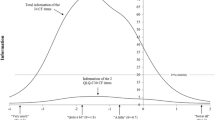Abstract
Purpose
A significant proportion of oncological patients experiences lack of appetite. Precise measurement is relevant to improve the management of lack of appetite. The so-called computer-adaptive test (CAT) allows for adaptation of the questionnaire to the individual patient, thereby optimizing measurement precision. The EORTC Quality of Life Group is developing a CAT version of the widely used EORTC QLQ-C30 questionnaire. Here, we report on the development of the lack of appetite CAT.
Methods
The EORTC approach to CAT development comprises four phases: literature search, operationalization, pre-testing, and field testing. Phases 1–3 are described in this paper. First, a list of items was retrieved from the literature. This was refined, deleting redundant and irrelevant items. Next, new items fitting the “QLQ-C30 item style” were created. These were evaluated by international samples of experts and cancer patients.
Results
The literature search generated a list of 146 items. After a comprehensive item selection procedure, the list was reduced to 24 items. These formed the basis for 21 new items fitting the QLQ-C30 item style. Expert evaluations (n = 10) and patient interviews (n = 49) reduced the list to 12 lack of appetite items.
Conclusions
Phases 1–3 resulted in 12 lack of appetite candidate items. Based on a field testing (phase 4), the psychometric characteristics of the items will be assessed and the final item bank will be generated. This CAT item bank is expected to provide precise and efficient measurement of lack of appetite while still being backward compatible to the original QLQ-C30 scale.

Similar content being viewed by others
References
Johnsen AT, Petersen MA, Pedersen L (2009) Symptoms and problems in a nationally representative sample of advanced cancer patients. Palliat Med 23:491–501
Liu Y, Xi Q-S, Xia S et al (2011) Association between symptoms and their severity with survival time in hospitalized patients with far advanced cancer. Palliat Med 25:682–690
Fearon K, Strasser F, Anker SD et al (2011) Definition and classification of cancer cachexia: an international consensus. Lancet Oncol 12:489–495
Davis MP, Dreicer R, Walsh D et al (2004) Appetite and cancer-associated anorexia: a review. J Clin Oncol 22:1510–1517
Maltoni M, Pirovano M, Scarpi E et al (1995) Prediction of survival of patients terminally ill with cancer. Results of an Italian prospective multicentric study. Cancer 75:2613–2622
Aaronson NK, Ahmedzai S, Bergman B et al (1993) The European Organization for Research and Treatment of Cancer QLQ-C30: a quality-of-life instrument for use in international clinical trials in oncology. J Natl Cancer Inst 85:365–376
Fayers P, Bottomley A (2002) Quality of life research within the EORTC—the EORTC QLQ-C30. European Organisation for Research and Treatment of Cancer. Eur J Cancer 38(Suppl4):S125–S133
Garratt A, Schmidt L, Mackintosh A et al (2002) Quality of life measurement: bibliographic study of patients assessed health outcome measures. BMJ 324:1417–1419
Petersen MA, Groenvold M, Aaronson NK et al (2010) Development of computerized adaptive testing (CAT) for the EORTC QLQ-C30 dimensions—general approach and initial results for physical functioning. Eur J Cancer 46:1352–1358
Petersen MA, Groenvold M, Aaronson NK et al (2011) Development of computerized adaptive testing (CAT) for the EORTC QLQ-C30 physical functioning dimension. Qual Life Res 20:479–490
Giesinger JM, Petersen MA, Groenvold M et al (2011) Cross-cultural development of an item list for computer-adaptive testing of fatigue in oncological patients. Health Qual Life Outcomes 9:19
Petersen MA, Aaronson NK, Arraras JI et al (2012) The EORTC computer-adaptive tests measuring physical functioning and fatigue exhibited high levels of measurement precision and efficiency. J Clin Epidemiol 66:330–339
Petersen MA, Giesinger JM, Holzner B, Arraras JI et al (2013) Psychometric evaluation of the EORTC computerized adaptive test (CAT) fatigue item pool. Qual Life Res 22(9):2443–2454
Gamper EM, Groenvold M, Petersen MA et al (2013) The EORTC Emotional Functioning computer adaptive test (CAT): phase I-III of a cross-cultural item bank development. Psycho-Oncology 23:397–403
Wainer H (2000) Computerized adaptive testing: a primer, 2nd edn. Lawrence Erlbaum Associates, Inc., Mahwah
Hambleton RK, Swaminathan H, Rogers HJ (1991) Fundamentals of item response theory. Sage Publications, Inc., Newbury Park
Kornblith AB, Holland JC (1994) Handbook of measures for psychological, social and physical function in cancer. Volume 1: quality of life. Memorial Sloan-Kettering Cancer Center, New York
McDowell I, Newell C (1996) Measuring health: a guide to scales and questionnaires, 2nd edn. University Press, Oxford
Johnson C, Aaronson N, Blazeby JM et al (2011) EORTC Quality of Life Group—guidelines for developing questionnaire modules, 4th edn. European Organisation for Research and Treatment of Cancer, Brussels
Dewolf L, Koller M, Velikoya G et al (2009) EORTC Quality of Life Group translation procedure. European organization for Research and Treatment of cancer, Brussels
Acknowledgments
The study was funded by grants from the EORTC Quality of Life Group, and the paper was developed on behalf of the group. The authors would like to thank the participating experts and patients for their essential evaluations and input.
Conflict of interest
None of the authors have any conflicts of interest with respect to this work.
Author information
Authors and Affiliations
Consortia
Corresponding author
Rights and permissions
About this article
Cite this article
Thamsborg, L.H., Petersen, M.A., Aaronson, N.K. et al. Development of a lack of appetite item bank for computer-adaptive testing (CAT). Support Care Cancer 23, 1541–1548 (2015). https://doi.org/10.1007/s00520-014-2498-3
Received:
Accepted:
Published:
Issue Date:
DOI: https://doi.org/10.1007/s00520-014-2498-3




